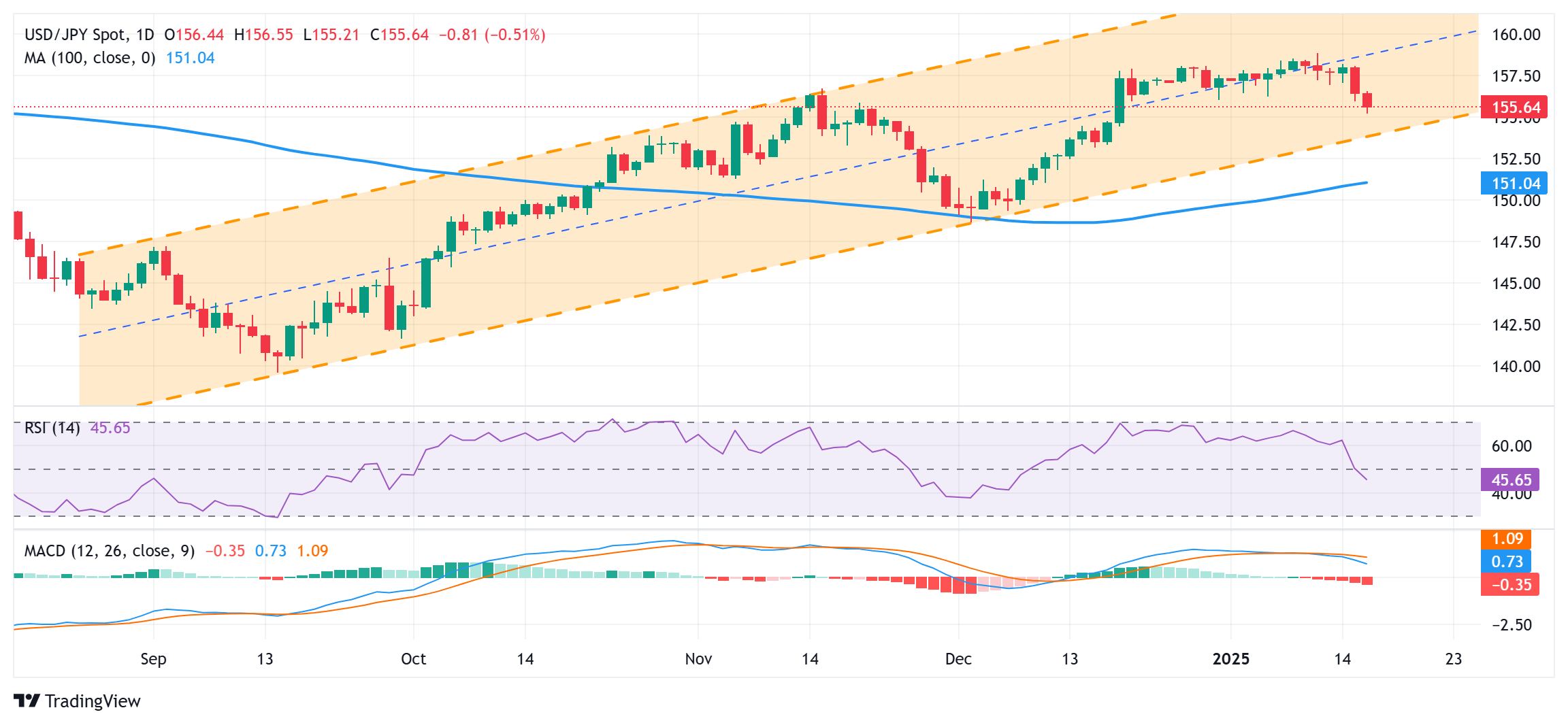- The Japanese Yen remains well supported by rising expectations of a BoJ rate hike in January.
- The narrowing of the yield differential between the US and Japan provides an additional boost to the JPY.
- The USD remains near a one-week low and further contributes to the decline of the USD/JPY pair.
The Japanese Yen (JPY) attracts buyers for the second day in a row on Thursday, supported by hawkish comments from Bank of Japan Governor Kazuo Ueda signaling a possible rate hike next week. Added to this are signs of widening inflationary pressures in Japan, supporting prospects for further policy tightening by the BoJ, pushing Japanese Government Bond (JGB) yields to multi-year highs. In contrast, US Treasury yields retreated sharply on Wednesday in reaction to benign US inflation data. The resulting narrowing of the US-Japan yield spread is seen as another factor. which undermines the JPY.
Meanwhile, lower-than-expected U.S. inflation raised the odds that the Federal Reserve could cut interest rates twice this year. This keeps the US Dollar (USD) bulls on the defensive and drags the USD/JPY pair to a new four-week low, around the 155.20 area during the Asian session on Thursday. That said, risk appetite could hold back traders from placing fresh bullish bets on the safe-haven JPY and offer some support to the currency pair. Investors are now looking to the US economic calendar, which includes the release of monthly Retail Sales and weekly Initial Jobless Claims, for short-term opportunities.
Japanese Yen remains supported by BoJ Governor Ueda’s hawkish comments on Wednesday
- Bank of Japan Governor Kazuo Ueda said Wednesday that the central bank will debate whether to raise interest rates at the next monetary policy meeting on Jan. 23-24.
- Ueda’s remarks mirror comments from Deputy Governor Ryozo Himino on Tuesday and raise expectations of a rate hike next week, providing a strong boost to the Japanese Yen.
- The 10-year Japanese government bond yield advanced to its highest level since 2011 amid prospects of further policy tightening by the BoJ.
- In contrast, US Treasury yields fell on Wednesday following the release of the US Consumer Price Index (CPI), which eased fears that inflation was accelerating.
- The US Bureau of Labor Statistics (BLS) reported that the headline CPI rose 0.4% in December and the annual rate accelerated to 2.9% from 2.7% the previous month.
- The underlying gauge, which excludes volatile food and energy prices, rose 3.2% year-over-year compared with November’s 3.3% rise and expectations.
- The US dollar fell to a one-week low following the release of the latest US consumer inflation figures and contributed to the decline in the USD/JPY pair on Wednesday.
- Richmond Fed President Tom Barkin said new inflation data shows progress in reducing inflation to the central bank’s 2% target, but added that rates should remain restrictive.
- Against the backdrop of easing fears over US President-elect Donald Trump’s disruptive trade tariffs, lower US inflation data remains supportive of market optimism.
- Traders look to US macroeconomic data for fresh momentum later in the North American session, although attention will remain focused on the BoJ’s next policy meeting.
USD/JPY could find support near 155.00 before falling to test ascending channel support
Any further decline will likely find some support near the 155.00 psychological level, below which the USD/JPY pair could slide to the 154.55-154.50 region. The latter represents the lower boundary of a four-month-old ascending channel and should act as a key point. A convincing break below will be seen as a new trigger for the bears and will pave the way for an extension of the recent decline from a multi-month peak touched last Friday. Spot prices could weaken further below the 154.00 level and test the next relevant support near the 153.40-153.35 horizontal zone.
On the other hand, any recovery attempt could now face resistance near the 156.00 level before the 156.35-156.45 region and the 156.75 zone. Some follow-up buying, leading to subsequent strength beyond the 157.00 level, could change the bias in favor of the bulls and lift the USD/JPY pair to the intermediate barrier of 155.55-155.60 en route towards the round figure of 158.00 . The momentum could extend further towards challenging the multi-month peak, around the 158.85-158.90 region.
Bank of Japan FAQs
The Bank of Japan (BoJ) is the Japanese central bank, which sets the country’s monetary policy. Its mandate is to issue banknotes and carry out monetary and currency control to ensure price stability, which means an inflation target of around 2%.
The Bank of Japan has embarked on ultra-loose monetary policy since 2013 in order to stimulate the economy and fuel inflation amid a low inflation environment. The bank’s policy is based on Quantitative and Qualitative Easing (QQE), or printing of banknotes to buy assets such as government or corporate bonds to provide liquidity. In 2016, the bank doubled down on its strategy and further relaxed policy by first introducing negative interest rates and then directly controlling the yield on its 10-year government bonds.
The Bank of Japan’s massive stimulus has caused the Yen to depreciate against its major currency pairs. This process has been exacerbated more recently by a growing policy divergence between the Bank of Japan and other major central banks, which have opted to sharply raise interest rates to combat inflation levels that have been at record highs for decades. The Bank of Japan’s policy of keeping rates low has caused the differential with other currencies to increase, dragging down the value of the Yen.
The weakness of the Yen and the rebound in global energy prices have caused a rise in Japanese inflation, which has exceeded the 2% target set by the Bank of Japan. Even so, the Bank of Japan judges that sustainable and stable achievement of the 2% objective is still not in sight, so a sudden change in current monetary policy seems unlikely.
Source: Fx Street
I am Joshua Winder, a senior-level journalist and editor at World Stock Market. I specialize in covering news related to the stock market and economic trends. With more than 8 years of experience in this field, I have become an expert in financial reporting.








